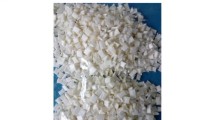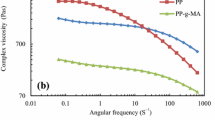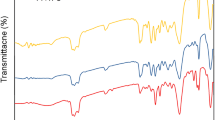Abstract
In this work, the self-reinforced polypropylene (PP)/noil ramie fiber (NRF) composites were prepared by the solid-state extrusion method. And the effect of die structure such as draw ratio and conical angle on the morphology, thermal and mechanical properties of samples was investigated. The results indicated that the solid-state deformation of PP/NRF composites conducted below the melt transition promoted the formation of the orderly arranged microfibrils inside the samples, which arranged along the extrusion direction and could be observed by scanning electron microscopy (SEM). Besides, the increased draw ratio and conical angle both contributed to the higher degree of orientation, which was obvious observed inside the sample prepared at the draw ratio of 5 and conical angle of 20°. The thermal properties tested by differential scanning calorimetry (DSC) also suggested that the intensified orientation of microfibrillar structure not only demonstrated the transformation of the spherulitic crystal into the aligned chain crystals, but also resulted in the enhanced crystallinity and narrowed melting peak. Moreover, the highly oriented fibrillar bundle structure endowed the samples with the excellent tensile strength and flexural strength, which were up to 80.9 MPa and 83.5 MPa respectively and increased by 182.8% and 102.7% compared with the commonly extruded samples.








Similar content being viewed by others
References
Pegoretti T, dos Santos MF, Evrard D et al (2014) Use of recycled natural fibres in industrial products: A comparative LCA case study on acoustic components in the Brazilian automotive sector. Resour Conserv Recy 84:1–14. https://doi.org/10.1016/j.resconrec.2013.12.010
Suwei W, Ke C, Mingyin J, Ping X (2019) Effect of processing conditions on the microstructure of microcellular PP/WF composites prepared by the continuous extrusion molding technology. Mater Res Express 7:015308. https://doi.org/10.1088/2053-1591/ab5d73
Suwei W, Ke C, Ping X, Mingyin J (2020) Research on the preparation and properties of foamed PP/wood flour composites. Mater Res Express 7:035308. https://doi.org/10.1088/2053-1591/ab802e
Bledzki A, Al-Mamun DA, Faruk O (2007) Abaca fibre reinforced PP composites and comparison with jute and flax fibre PP composites. Express Polym Lett 1:755–762. https://doi.org/10.3144/expresspolymlett.2007.104
Kim SJ, Moon JB, Kim GH, Ha CS (2008) Mechanical properties of polypropylene/natural fiber composites: comparison of wood fiber and cotton fiber. Polym Test 27:801–806. https://doi.org/10.1016/j.polymertesting.2008.06.002
Li X, He L, Zhou H, Li W, Zha W (2012) Influence of silicone oil modification on properties of ramie fiber reinforced polypropylene composites. Carbohyd Polym 87:2000–2004. https://doi.org/10.1016/j.carbpol.2011.10.023
Faruk O, Bledzki A K, Fink H P ,Sain M (2012) Biocomposites reinforced with natural fibers: 2000–2010. ProgPolymSci 37.https://doi.org/10.1016/j.progpolymsci.2012.04.003
Li Y, Moyo S, Ding Z, Shan Z, Qiu Y (2013) Helium plasma treatment of ethanol-pretreated ramie fabrics for improving the mechanical properties of ramie/polypropylene composites. Ind Crop Prod 51:299–305. https://doi.org/10.1016/j.indcrop.2013.09.028
Zhou M, Xu S, Li Y, He C, Jin T, Wang K et al (2014) Transcrystalline formation and properties of polypropylene on the surface of ramie fiber as induced by shear or dopamine modification. Polymer 55:3045–3053. https://doi.org/10.1016/j.polymer.2014.05.013
Chapleau N, Mohanraj J, Ajji A, Ward IM (2005) Roll-drawing and die-drawing of toughened poly(ethylene terephthalate). Part 1. Structure and mechanical characterization. Polymer 46:1956–1966. https://doi.org/10.1016/j.polymer.2004.10.089
Mourad AHI, Bekheet N, El-Butch A, Abdel-Latif L, Nafee D, Barton DC (2005) The effects of process parameters on the mechanical properties of die drawn polypropylene. Polym Test 24:169–180. https://doi.org/10.1016/j.polymertesting.2004.09.006
Mohanraj J, Bonner MJ, Barton DC, Ward IM (2006) Physical and mechanical characterization of oriented polyoxymethylene produced by die-drawing and hydrostatic extrusion. Polymer 47:5897–5908. https://doi.org/10.1016/j.polymer.2006.05.056
Jianchen C, Mingyin J, Ping X et al (2014) Physical and mechanical characterization of self-reinforced wood–polymer composite produced by solid-state extrusion. J Thermoplast Compos 27:1321–1333. https://doi.org/10.1177/0892705712471361
Polec I, Hine PJ, Bonner MJ, Ward IM, Barton DC (2010) Die drawn wood polymer composites. I. Mechanical properties. Compos Sci Technol 70:45–52. https://doi.org/10.1016/j.compscitech.2009.09.005
Jianchen C, Mingyin J, Ping X et al (2013) The effect of processing conditions on the mechanical properties and morphology of self-reinforced wood-polymer composite. Polym Composite 34:1567–1574. https://doi.org/10.1002/pc.22553
Masoumi A, Craggs G (1997) Design of strain-rate-controlled dies for the die drawing of polymer sheet. J Mater Process Tech 72:407–412. https://doi.org/10.1016/S0924-0136(97)00203-3
Feng Y, Hu Y, Zhao G, Yin J, Jiang W (2011) Preparation and mechanical properties of high-performance short ramie fiber-reinforced polypropylene composites. J Appl Polym Sci 122:1564–1571. https://doi.org/10.1002/app.34281
Zhang Y, Xue P, Ding Y, Jia M, Shi Z, Wang H (2016) Improvement of mechanical, dynamic -mechanical and thermal properties for noil ramie fiber reinforced polyethylene composites. Trans Nanjing Univ Aero Astro 33:121–128. https://doi.org/10.16356/j.1005-1120.2016.01.121
Kmetty Á, Bárány T, Karger-Kocsis J (2010) Self-reinforced polymeric materials: a review. Prog Polym Sci 35:1288–1310. https://doi.org/10.1016/j.progpolymsci.2010.07.002
Luo Y, Xin C, Yang Z, Yan B, He Y (2014) Solid-state foaming of isotactic polypropylene and its composites with spherical or fibrous poly(butylenes terephthalate). J Appl Polym Sci 132.https://doi.org/10.1002/app.41801
Suwei W, Ping X, Mingyin J, Ke C (2019a) Effect of Polymer Blends on the Properties of Foamed Wood-Polymer Composites. Materials 12:1971. https://doi.org/10.3390/ma12121971
Suwei W, Ping X, Mingyin J, Ke C (2019b) Extrusion foaming behavior of wood plastic composites based on PP/POE blends. Mater Res Express 6:115345. https://doi.org/10.1088/2053-1591/ab4f0c
Zhao X, Ye L (2011) Structure and properties of highly oriented polyoxymethylene produced by hot stretching. Mat Sci Eng 528:4585–4591. https://doi.org/10.1016/j.msea.2011.02.039
Matthews RG, Ajji A, Dumoulin MM, Prud’hommeb RE (2000) The effects of stress relaxation on the structure and orientation of tensile drawn poly(ethylene terephthalate). Polymer 41:7139–7145. https://doi.org/10.1016/s0032-3861(00)00052-5
Obadal M, Cermák R, Stoklasa K, Habrová V (2004) Extrusion of self-reinforced polyethylene. Plast Rubber Compos 33:295–298. https://doi.org/10.1179/174328904X19985
Alcock B, Cabrera NO, Barkoula NM, Loos J, Peijs T (2007) Interfacial properties of highly oriented coextruded polypropylene tapes for the creation of recyclable all-polypropylene composites. J Appl Polym Sci 104:118–129. https://doi.org/10.1002/app.24588
Qing G, Xiaoguang Z, Dan C et al (1996) Self-reinforcement of polypropylene by oscillating packing injection molding under low pressure. J Appl Polym Sci 62:755–762. https://doi.org/10.1002/(SICI)1097-4628(19961031)62:5<755::AID-APP6>3.0.CO
Youbing L, Jing C, Kaizhi S (2008) Self-reinforced isotactic polypropylene prepared by melt vibration injection molding. Polym-Plast Technol 47:673–677. https://doi.org/10.1080/03602550802129551
Pukánszky B (1995) Polypropylene structure, blends and composites. https://doi.org/10.1007/978-94-011-0523-1_1
Author information
Authors and Affiliations
Corresponding author
Additional information
Publisher’s note
Springer Nature remains neutral with regard to jurisdictional claims in published maps and institutional affiliations.
Rights and permissions
About this article
Cite this article
Wang, S., Shi, Z., Cai, J. et al. Effect of die structure on the properties of self-reinforced polypropylene/noil ramie fiber composites prepared by solid-state extrusion. J Polym Res 27, 334 (2020). https://doi.org/10.1007/s10965-020-02316-w
Received:
Accepted:
Published:
DOI: https://doi.org/10.1007/s10965-020-02316-w




